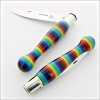-
The BladeForums.com 2024 Traditional Knife is ready to order! See this thread for details: https://www.bladeforums.com/threads/bladeforums-2024-traditional-knife.2003187/
Price is$300$250 ea (shipped within CONUS). If you live outside the US, I will contact you after your order for extra shipping charges.
Order here: https://www.bladeforums.com/help/2024-traditional/ - Order as many as you like, we have plenty.
You are using an out of date browser. It may not display this or other websites correctly.
You should upgrade or use an alternative browser.
You should upgrade or use an alternative browser.
LC200N
- Thread starter XtianAus
- Start date
- Joined
- Jul 23, 2015
- Messages
- 17,826
I had it heat treated by Jarod Todd. He can get it close to 61 HRC which is about as high as it goes to my knowledge, and where it belongs, in my opinion.
MagnaCut makes it obsolete for my uses.
MagnaCut makes it obsolete for my uses.
- Joined
- Jul 23, 2015
- Messages
- 17,826
Last I checked it was nearly eight times more expensive to acquire in North America than AEB-L. One of the reasons I moved away from it.
- Joined
- Jan 30, 2025
- Messages
- 179
Would the same essentially be said for vanax super clean?Last I checked it was nearly eight times more expensive to acquire in North America than AEB-L. One of the reasons I moved away from it.
- Joined
- Jul 23, 2015
- Messages
- 17,826
No idea.
- Joined
- Jul 30, 2006
- Messages
- 43,814
LC200N was developed for space applications, where performance requirements are extreme and the cost of failure ridiculously high. So you are paying for that level of performance. You are also paying for it being a low usage alloy. Not many people need the specific performance that it gives. You could call it a "Boutique steel" .8x? Wow!
I guess you'd really need/want the stainlessness to go for it.
I like AEBL a lot. But I also haven't found it very stainless (I guess HT also affects this)
What are you doing that AEBL is corroding?
I live a couple of miles from the beach, have dozens of knives in various stainless steels, and have not had any corrosion issues on any of them.
XtianAus
Gold Member
- Joined
- Mar 3, 2016
- Messages
- 3,154
Man that's cool. What a facinating steel. Similarly specialized to Vanax by the sound of it.LC200N was developed for space applications, where performance requirements are extreme and the cost of failure ridiculously high. So you are paying for that level of performance. You are also paying for it being a low usage alloy. Not many people need the specific performance that it gives. You could call it a "Boutique steel" .
What are you doing that AEBL is corroding?
I live a couple of miles from the beach, have dozens of knives in various stainless steels, and have not had any corrosion issues on any of them.
I have only had it twice from one maker but it was corroding along the tang where the handle is. I think from my hands. I have very acidic skin. You can tell which side of the bed is mine because of the bleach like stain I leave lol.
It wasn't a big deal. I can manage it but it really annoys me. I hate rust, I have such ocd with it so merely holding a knife causing it to rust is infuriating.
- Joined
- Jul 23, 2015
- Messages
- 17,826
If anyone wants a knife made of LC200N I will make it, if they want to pay the Premium. It'll be ridiculously high.
- Joined
- Jul 23, 2015
- Messages
- 17,826
I guess HT also affects this
According to my research, LC200N stainlessness is independent of its heat treatment, and entirely dependent on its alloy composition.
XtianAus
Gold Member
- Joined
- Mar 3, 2016
- Messages
- 3,154
Oh sorry I mean AEBLAccording to my research, LC200N stainlessness is independent of its heat treatment, and entirely dependent on its alloy composition.
- Joined
- Jul 23, 2015
- Messages
- 17,826
I have only had it twice from one maker but it was corroding along the tang where the handle is.
One possibility comes to mind, which is galvanic corrosion due to possible contaminant particles of a foreign alloy.
- Joined
- Jul 23, 2015
- Messages
- 17,826
Oh sorry I mean AEBL
Okay so the LC200N knife is not rusting at the handle, it's AEB-L?
XtianAus
Gold Member
- Joined
- Mar 3, 2016
- Messages
- 3,154
That's rightOkay so the LC200N knife is not rusting at the handle, it's AEB-L?
Due to high ph levels in my skin is my guess. I had no subjected it to any water
- Joined
- Jul 30, 2006
- Messages
- 43,814
Yes it does.One possibility comes to mind, which is galvanic corrosion due to possible contaminant particles of a foreign alloy.
Stainless steel is "stainless" because of a tightly adhering oxide layer which is only a couple of atoms thick. The layer prevents oxygen and water from contacting the iron. If the layer gets contaminated, it becomes an imperfect barrier and corrosion can occur. This can occur if tools and abrasives which have been used on non-stainless steels are subsequently used on stainless steel. Non-stainless particles can become embedded in the stainless steel surface. If they do, they create a pathway for moisture/oxygen.
So I have to wonder how the tang surface was prepared for the handle. I suggest removing the corrosion by cleaning the surface to remove any oils, then light abrasion (scuff sanding) using a new piece of aluminum oxide sandpaper (180-220 grit) which has not been used on anything else. This should remove any contaminant. If you can remove the handle pieces first, that would result in a more complete treatment.
Acids can cause corrosion, but it needs to be very acidic. If it actually is acidic skin oils, you might try cleaning the knife before you put it into storage, similar to what is done with carbon steel blades.
- Joined
- Jul 23, 2015
- Messages
- 17,826
If it actually is acidic skin oils, you might try
A trip to the doctor and nutritionist.
XtianAus
Gold Member
- Joined
- Mar 3, 2016
- Messages
- 3,154
This is very possible because this particular maker also works with 3VStainless steel is "stainless" because of a tightly adhering oxide layer which is only a couple of atoms thick. The layer prevents oxygen and water from contacting the iron. If the layer gets contaminated, it becomes an imperfect barrier and corrosion can occur. This can occur if tools and abrasives which have been used on non-stainless steels are subsequently used on stainless steel. Non-stainless particles can become embedded in the stainless steel surface. If they do, they create a pathway for moisture/oxygen.
- Joined
- Aug 20, 2022
- Messages
- 1,436
I was wondering. Is this AI? Did someone drug my drink? Why are Knerfang and Mavid Dary moving in colorful slow motion?


